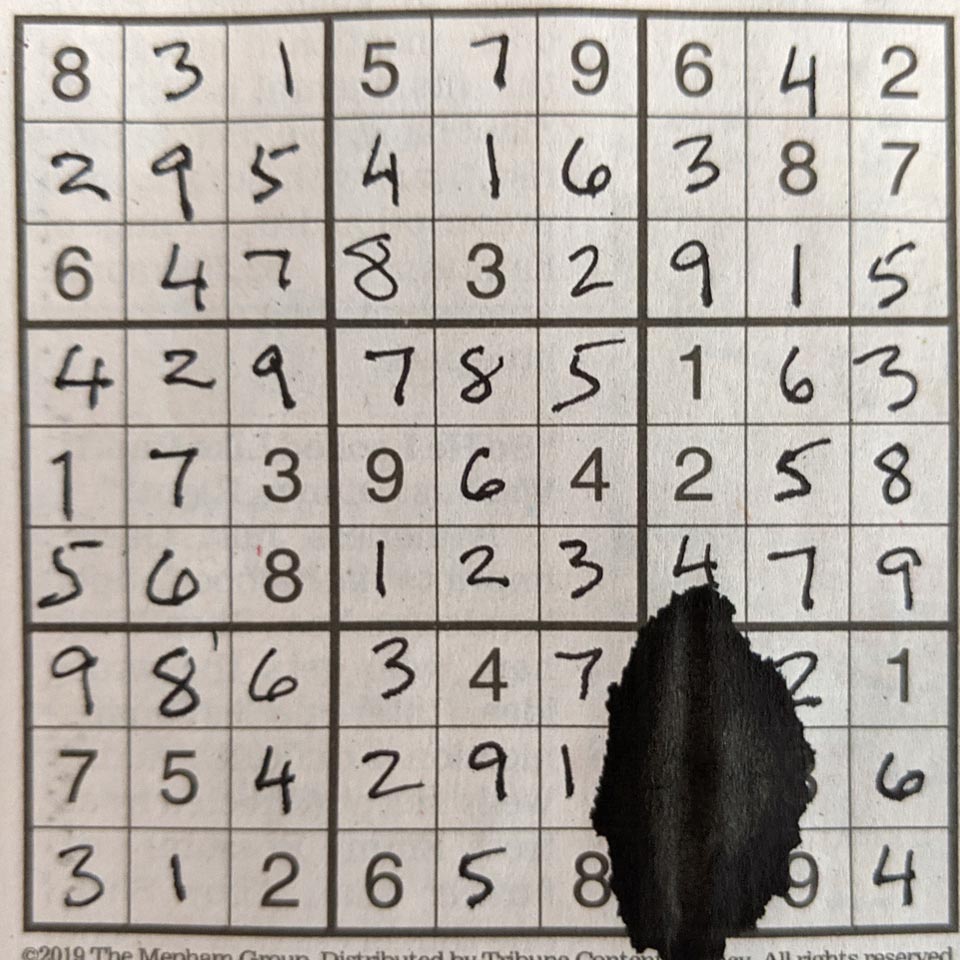Halloween linkage
-
Quasiperiodic bobbin lace patterns (\(\mathbb{M}\), via). Veronika Irvine, Therese Biedl, and Craig S. Kaplan make aperiodic tilings in fiber arts.
-
Pen refill mishap added a little extra challenge to my daily newspaper sudoku.

-
Thinking outside the plane (\(\mathbb{M}\)). Interesting roundup of 3d solutions to 2d problems, starting with Tarski’s plank problem: Can you cover a diameter-\(n\) disk with fewer than \(n\) unit-width strips? Sadly, they missed the 3d proof of Desargues’ theorem. There’s also a 2d-3d connection with Miquel’s six-circle theorem but I think it goes the other way.
-
ACM takes conference-sponsorship money from surveillance-tech company Palantir, for its conference on CS and the law (\(\mathbb{M}\)). If you’re wondering what’s up with the article’s lead image of a protest banner that draws the analogy IBM : Nazis :: Palantir : ICE, see TheHill on Palantir and ICE, and Edwin Black’s book IBM and the Holocaust: The Strategic Alliance Between Nazi Germany and America’s Most Powerful Corporation (2001).
-
Where research meets profits (\(\mathbb{M}\)).
-
American Psychological Association hires anti-piracy firm to police its paywalled papers
-
Firm files takedowns against association members for putting their own papers online
-
Refereeing strike!
But the strikers’ demands for pay or no policing seem off to me. I’d rather the societies take to heart their members’ interests in making research public, and make it all open access. They have plenty of other opportunities for revenue.
-
-
In his latest alphabet entry “Platonic” (\(\mathbb{M}\)), Joseph Nebus writes that “it was obvious” that eight equal charged particles free to move on a sphere would space themselves out into the vertices of a cube. And it is obvious, but sadly, in this case, the obvious is false. They form a square antiprism instead.
-
efz1005 finds cellular-automaton-like moving patterns in the results of repeated Sobel filtering.
-
I saw MOMIX dance recently (\(\mathbb{M}\)). Nobody seems to have pointed out that the big rolling sculpture in their “Dream Catcher” has the shape of an oloid so I added that to the Wikipedia article. An earlier MOMIX piece with another big rolling sculpture is based on the sphericon, and was discovered by MOMIX dancer/sculptor Alan Boeding prior to one of the two previously listed discoveries of the sphericon.
-
Farewell to the fractional foot (\(\mathbb{M}\)). Obviously, the US lags everyone else in using metric, which makes much more sense than imperial (just for length, we have mils, inches, feet, yards, miles, chains, furlongs, leagues, fathoms, cables, nautical miles, links, and rods!) But I did not know that we have two incompatible feet (1200/3937 m and 0.3048 m) and we’re lagging even in getting rid of the stupider of the two. Quickly, without looking it up: is 3937 prime?
-
Guess again: The Ehrenfeucht-Mycielski sequence (\(\mathbb{M}\)). Jim Propp explains how this binary sequence can fool pattern-matching methods that base their predictions for future bits on longest matches, and describes an open problem on how close to evenly split between 0’s and 1’s its bits are.
-
Timothy Gowers welcomes the launch of the new online journal Advances in Combinatorics (\(\mathbb{M}\)). Like the earlier journal Discrete Analysis (and the technical part of CACM), every paper comes with a one-page overview by the editors explaining the significance of the result in more general terms.
-
Jessen’s icosahedron (\(\mathbb{M}\)) is a non-convex shape with right-angled dihedrals but not axis-aligned faces. It’s rigid but not infinitesimally, so paper models are hard to make accurately. I drew the Wikipedia article’s new lead image after the article had for years shown the wrong shape (with vertices of a regular icosahedron). Surely someone else can do better? Also it can be cut into pieces and reassembled into cubes. Anyone know an explicit construction?
-
Mathematicians cut apart shapes to find pieces of equations (\(\mathbb{M}\)). Despite the misleading bits — it’s only regular tetrahedra that can’t be dissected into cubes, not all unit volume tetrahedra, and the Dehn invariant cannot really be called a number — this Quanta story is an interesting popular summary of scissors congruence, Hilbert’s third problem, the Dehn invariant, and progress in higher dimensions.